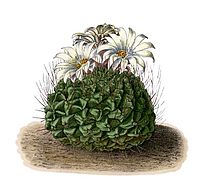Strombocactus
| Strombocactus | |
|---|---|

| |
| Strombocactus disciformis subsp. disciformis | |
| Scientific classification | |
| Kingdom: | Plantae |
| Clade: | Tracheophytes |
| Clade: | Angiosperms |
| Clade: | Eudicots |
| Order: | Caryophyllales |
| Family: | Cactaceae |
| Subfamily: | Cactoideae |
| Tribe: | Cacteae |
| Genus: | Strombocactus Britton & Rose |
| Species: | S. disciformis
|
| Binomial name | |
| Strombocactus disciformis | |
| Synonyms | |
|
Ariocarpus disciformis (DC.) Marshall | |
Strombocactus disciformis is a rare species of cacti and the only species of the genus Strombocactus. The plant originates from Central and Northeast Mexico.
Description[edit]
Strombocactus is a monotypic genus with a strong turnip-like root, a small, depressed, roughly spherical stem covered with spirally arranged overlapping tubercles, each with a spine-bearing areole at its tip.
Strombocactus disciformis are low-growing, gray-green succulents with a broadly round, unbranched stem and root. In their natural habitats, they grow in a disk shape, half hidden in the ground, reaching around 8 cm in diameter and 2-3 cm in height. In cultivation, they become nearly spherical. Adult tubers can reach 15 cm in diameter, larger than the above-ground parts. The plant's spiral ribs are deeply notched, creating a wart-like appearance with a ratio close to the golden ratio (13:8). Areoles are located on the blunt ends of these warts, which are curved (straighter in cultivation) and have a square base. They rarely have more than four or five short, bristly thorns, which fall off after a few years.[2]
Flowers come from new growth at the crown, emerging from the youngest areoles. The flowers, white to cream or magenta and 2.5 to 3.5 cm long and open to about 4 cm in diameter. The 7 mm long, thin-walled brown fruits contain 0.3 mm reddish-brown seeds.[3].
-
Growth habit
-
Flowers
-
Spines
-
Seedling
-
View of plant from the top
Subspecies[edit]
The species has two recognized subspecies:[4]
| Image | Subspecies | Distribution |
|---|---|---|
 |
Strombocactus disciformis subsp. disciformis | Querétaro to Hidalgo |
 |
Strombocactus disciformis subsp. esperanzae Glass & S.Arias | Guanajuato |
Distribution[edit]
Strombocactus disciformis is found in the Mexican states of Querétaro, Hidalgo, and Guanajuato, growing on almost vertical, weathered limestone rocks at altitudes of 1000 to 1600 meters.[5]
-
Plant growing vertically in habitat in Pena Blanca, Queretaro
-
Plants growing on rocks in Pena Blanca, Queretaro
-
Plant growing with Mammillaria parkinsonii
Taxonomy[edit]

First described as Mammillaria disciformis by Augustin-Pyrame de Candolle in 1828, the specific epithet disciformis is derived from the Latin "discus" (disc) and "-formis" (shaped), referring to the plant's shape.[6] Nathaniel Lord Britton and Joseph Nelson Rose reclassified it as Strombocactus in 1922.[7]
Conservation status[edit]
Both subspecies are classified as Vulnerable on the IUCN Red List, which states that it has a limited range and "is experiencing a decline in mature individuals due to illegal overcollection". The species is listed in Appendix 1 of the Convention on International Trade in Endangered Species meaning commercial international trade is prohibited and non-commercial international trade is regulated.[1]
References[edit]
- ^ a b "Appendices | CITES". cites.org. Retrieved 2022-01-14.
- ^ Anderson, Edward F.; Eggli, Urs (2005). Das grosse Kakteen-Lexikon (in German). Stuttgart (Hohenheim): Ulmer. p. 607–608. ISBN 3-8001-4573-1.
- ^ Venning, Frank D. Cacti (A Golden Guide). Racine, Wisconsin: Western Publishing Company, Inc. p. 155.
- ^ "Strombocactus disciformis (DC.) Britton & Rose". Plants of the World Online. Retrieved 2024-06-11.
- ^ Vallicelli, Valentino (2013-08-04). "Strombocactus disciformis". LLIFLE. Retrieved 2024-06-11.
 This article incorporates text from this source, which is available under the CC BY-SA 3.0 license.
This article incorporates text from this source, which is available under the CC BY-SA 3.0 license.
- ^ D&Amp, Um National; (France), histoire naturelle (1828). "Mémoires du Muséum d'histoire naturelle". G. Dufour. Retrieved 2024-06-11.
- ^ Britton, Nathaniel Lord; Eaton, Mary E.; Rose, J. N.; Wood, Helen Adelaide (1919). The Cactaceae : descriptions and illustrations of plants of the cactus family. Washington: Carnegie Institution of Washington. doi:10.5962/bhl.title.46288.
External links[edit]
 Media related to Strombocactus at Wikimedia Commons
Media related to Strombocactus at Wikimedia Commons Data related to Strombocactus at Wikispecies
Data related to Strombocactus at Wikispecies









